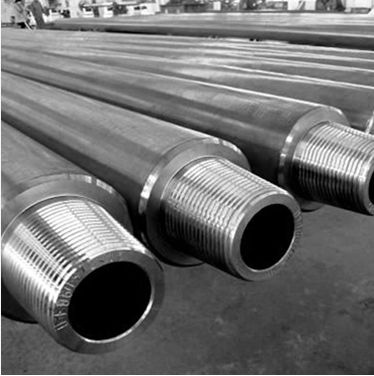I. Source Control: Continuous Pursuit of Refinement in Materials and Manufacturing Processes
Strict Material Selection:
High-Strength Alloy Steel: Specialized alloy steels must comply with API Spec 5DP (Drill Pipe Specification) or other more stringent industry/company standards. The steel must possess excellent comprehensive mechanical properties (high strength, high toughness, and good fatigue life) and specific environmental adaptability, including resistance to hydrogen sulfide stress corrosion cracking (SSCC).

Material Traceability: From billet to finished product, material batch, heat number, chemical composition, and mechanical property test reports must be fully documented and traceable at every stage to ensure reliable material source.
Precision Manufacturing Process:
Seamless Steel Pipe Forming: The mainstream process utilizes a seamless steel pipe piercing-rolling-sizing process to ensure seamless pipes, uniform strength, and avoid welds becoming potential failure points.
Heat Treatment of Critical Areas: The drill pipe body (tube) and upset end areas undergo precise quenching and tempering heat treatment to achieve the ideal metallographic structure (e.g., tempered bainite) and optimize the balance of strength, hardness, and toughness.
End Upset: Both ends of the drill pipe are thickened through forging or hot extrusion to provide sufficient wall thickness support for subsequent high-strength thread processing, significantly improving the torsional and tensile strength of the connection.
Thread Processing and Inspection:
API standard threads (e.g., NC, IF, FH) or special threads (e.g., Premium Connection) are processed using high-precision CNC machine tools.
Thread geometry (taper, pitch, tooth height, pitch), surface finish, and lead angle must strictly comply with standard requirements.
Precision thread gauges (working and setting gauges) are used for 100% in-line inspection.
Surface treatments such as phosphating and copper plating are applied to threads to reduce friction, wear, and galling during make-up and break-out.
2. Sharp Eyes: Full-Process Nondestructive Testing (NDT)
Nondestructive testing (NDT) is the core line of defense for eliminating potential defects and ensuring the structural integrity of drill pipe. It must cover key aspects of the drill pipe lifecycle:
Pipe Inspection:
Ultrasonic Testing (UT): Detects longitudinal and transverse defects (such as cracks, inclusions, and folds) within and near the surface of the pipe body. A multi-channel automated UT system is used to ensure full coverage.
Magnetic Magnetic Leakage (MFL): Primarily used to detect volumetric defects such as corrosion pits and mechanical damage on the pipe surface. It is sensitive to wall thickness reduction.
Thickening Transition Zone Inspection:
This area has significant stress concentration and is prone to fatigue cracking. High-sensitivity inspection requires specialized focused probes or phased array ultrasonic testing (PAUT) to ensure the absence of dangerous defects such as cracks and folds.
Threaded Area Inspection:
Magnetic Particle Testing (MT) or Liquid Penetrant Testing (PT): Detects surface and near-surface cracks at the thread root, flanks, and end faces.
Optical/Laser Inspection: High-precision measurement of thread topography to ensure perfect geometry.
Weld Area Inspection (if applicable):
Welds on drill pipe and tool joints (e.g., those connected by friction welding) are rigorously inspected using UT, MT, or PT to ensure weld fusion quality and the absence of defects in the heat-affected zone.
III. Performance Verification: Hard-core Endorsement from Laboratory Testing
Mechanical Property Testing:
Tensile Testing: Determines yield strength, tensile strength, elongation, and reduction of area to verify material strength and ductility.
Charpy V-Notch Impact Testing: Determines the impact energy of a material at a specified temperature to assess its toughness, particularly its resistance to brittle fracture in low-temperature environments or where stress corrosion is a concern.
Hardness Testing: Checks whether the hardness distribution of the pipe body, upset end, and threaded area meets requirements, indirectly reflecting material strength and heat treatment effectiveness.
Threaded Connection Performance Testing:
Hydrostatic Pressure Testing: Verifies the sealing integrity of the pipe body and threaded connection.
Make-up and Break-out Testing: Simulates actual operating conditions to evaluate the anti-galling performance and reusability of threads.
Ultimate Load Testing (if applicable): This test examines the extreme performance of special threads or critical products under combined loads such as tension, compression, internal pressure, external pressure, and bending.
Full-Scale Fatigue Testing:
This test simulates downhole bending and rotational conditions to evaluate the fatigue life of drill pipe under actual service conditions. It is one of the most direct means of verifying design and manufacturing quality.
IV. Specifications and Certification: A Solid Backing for the Quality System
Adherence to Authoritative Standards:
API Spec 5DP: The cornerstone standard for drill pipe manufacturing and inspection worldwide, with mandatory requirements for materials, dimensions, workmanship, inspection, marking, etc.
API Spec 7-1: Standardizes drill pipe threading and gaging requirements.
API RP 7G: Provides recommended practices for the use, inspection, and maintenance of
drill pipe.
ISO 11961: A standard similar to API 5DP published by the International Organization for Standardization.
Customer-Specific Specifications (CPS): Large oil companies or drilling contractors often have more stringent internal standards.
Quality System Certification:
Manufacturers must establish and effectively operate a quality management system that complies with ISO 9001 (Quality Management System) standards.
Obtaining API Monogram certification is crucial, demonstrating that their products consistently comply with API specifications and authorizing the use of the API Monogram on their products.
Third-Party Inspection and Certification:
Introducing independent third-party inspection organizations (such as DNV, ABS, and BV) to conduct process audits, product inspections, and certifications, providing objective and impartial quality assurance.

